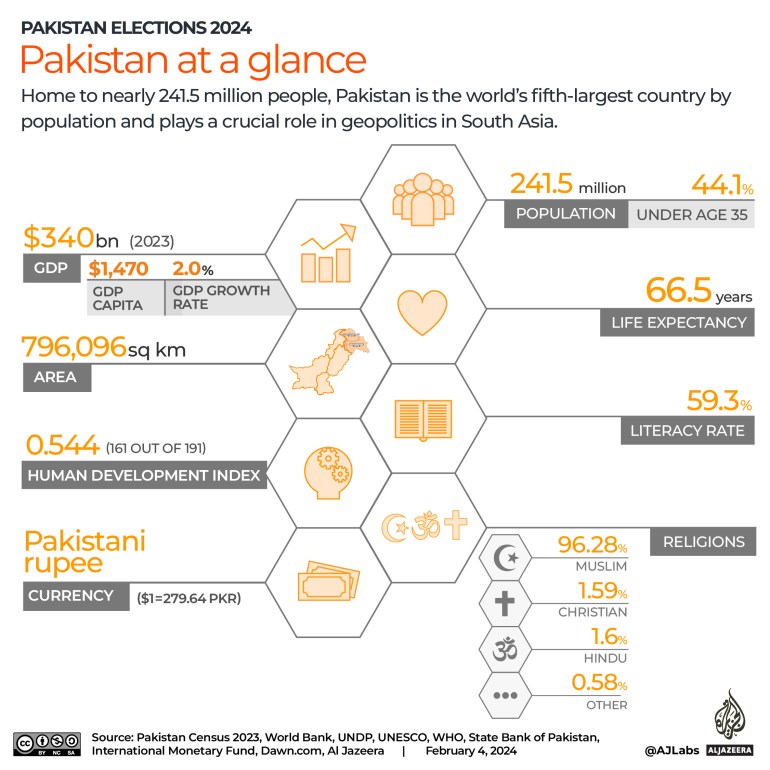“We have power outages every day for two hours,” says Muhammad Waqas, a janitor from Islamabad. “In the summer, when it’s hot, you sit idly and suffer.”
As with other state-owned firms, the inability of successive governments to invest in Pakistan’s National Transmission and Despatch Company has left it prone to failure.
More recently, the COVID-19 pandemic and energy supply challenges dampened Pakistan’s growth prospects and constrained efforts to diversify its export base away from low-value-added products – such as cotton and rice – to higher-value goods.
In late 2022, meanwhile, monsoon floods displaced eight million people and cost the country $30bn in damage. The loss of cotton crops ravaged the country’s textile industry, a key source of exports. In all likelihood, Pakistan’s growth rate fell into negative territory in 2023.
Pakistan, which imports much of its food and fuel, consistently records large trade deficits. Owing in part to elevated commodity prices, foreign exchange reserves dwindled to less than one month of imports last May, leading to shortages of vital goods.
The following month, Islamabad narrowly avoided default after it secured a $3bn loan from the IMF – its 23rd fund programme since 1958. However, the lending package came with strict conditions and unpopular reforms.
As part of the deal, the government agreed to impose new taxes on its faltering power sector. It also agreed to lower utility subsidies, which led to sharp hikes in electricity prices, hitting poorer households particularly hard.
Inflation, which reached nearly 30 percent in December, has been climbing since the start of last year after Pakistan’s central bank agreed to liberalise its exchange rate as part of a pre-existing IMF programme. Once exchange controls were dropped, the value of the currency fell sharply.
The Pakistani rupee was Asia’s worst-performing currency in 2023, depreciating by roughly 20 percent against the US dollar. “We think the rupee will continue trending down slightly,” said Krisjanis Krustins, a director at Fitch Ratings. “This will lower Pakistan’s current account deficit as goods from abroad will become more expensive, compressing import levels.”
According to the State Bank of Pakistan, the country posted a balance of payments surplus of $397m last December.
Krustins told Al Jazeera, “Pakistan’s goods imports fell by 27 percent in the last calendar year. As for exports, they continue to be held back by limited human capital and poor infrastructure. So, corrections in the trade account have had a depressing impact on the economy.”
Recent job losses have lifted the official unemployment rate to a record high of 8.5 percent, pitching an additional 8.4 to 9.1 million people into poverty.
‘Structural issues’
Separately, Pakistan has long suffered from “structural issues”, says Tariq Banuri, professor of economics at the University of Utah.
“For starters, Pakistan’s growth rate is not high enough to absorb its rapidly expanding population. It’s also one of the world’s worst performers on tax collection. Agricultural landowners are exempt from income tax, and there’s no capital gains tax on real estate.”
Successive governments have stopped short of imposing robust tax legislation for fear of upsetting powerful business interests, Banuri said. “But that may change this year because of the debt situation,” he added.
Islamabad’s failure to boost tax revenues and modernise state-owned enterprises has generated persistent fiscal deficits and a large debt burden. In absolute terms, external debt reached $125.7bn last year.
Looking ahead, Pakistan faces $24.6bn in external debt repayments by the end of June, the bulk of which is owed to China.
China is Pakistan’s largest bilateral creditor, and Beijing agreed to roll over $2.4bn in loans last year. Many economists expect the incoming government to try and secure longer-term financing from the IMF – its current deal expires in April.
Given the cutbacks to public spending last year, “further fiscal consolidation is unlikely”, says Yousuf Farooq, director of research at Chase Securities. “The Fund is going to try and eke out further conditions, but probably from wealthier sections of society.”
“Assuming the new government can get another IMF loan, it will struggle to repay unless it imposes new taxes on agriculture and real estate. If it can also roll over short-term contracts with longer repayment schedules, I’m hopeful that debt will fall in the near term,” he said.
In the meantime, foreign investment continues to be hamstrung by security concerns along the Pakistan-Afghanistan border. Since the Taliban returned to power in Kabul in 2021, Islamabad has accused its neighbour of harbouring fighters carrying out attacks on its soil.
Political crisis
An unfolding political crisis is also threatening Pakistan’s economic recovery. Today, Islamabad’s fragile democracy is overseen by a caretaker government following Imran Khan’s dismissal as prime minister in April 2022.
The legitimacy of the February 8 elections has been questioned as Khan is absent from the ballot sheet. He is in jail on corruption charges. And while he is disqualified from running, Khan’s approval rating stands at 57 percent, higher than any other politician.
As things stand, the head of the Pakistan Muslim League-Nawaz (PMLN) – is favourite to win. Sharif’s PMLN has assumed power four times in the past three decades, under either himself or his brother Shehbaz Sharif.
Earlier this month, the Supreme Court further weakened Khan’s Pakistan Tehreek-e-Insaf (PTI) campaign by banning the use of a cricket bat as its symbol – a serious setback in a country where millions of illiterate voters identify candidates by their party logos.
For Banuri, the economics professor, “People are right to criticise Pakistan’s political system, which is dynastic and extractive. But for all that, I remain an optimist. I think the worst of the economic crisis is behind us.”
“While I always hope tomorrow will be better than today, I do not think the main political parties will offer meaningful change. They seem to be far more concerned with getting into power,” he added.

